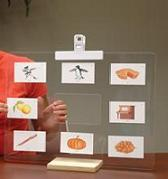Many people who use AAC have difficulty pointing or reaching for symbols to communicate, however they may be able to use their eyes very effectively. People can express their preferences by looking at real objects and/or pictures to make choices. Words and letters can also be used for eye gaze communication.
When you first start introducing eye gaze, you can hold up two objects or pictures for the person to choose between. As you increase the number of choices offered, it may be beneficial to present the symbols on an eye gaze frame.
Eye Gaze Frame Options:

Often eye gaze frames are constructed from clear plastic with a hole in the middle to allow the communication partner to see exactly where the person's eyes are pointing. They may be called "Eye Gaze Frames" or "Eye Gaze Boards".

You can use a variety of materials to create your own eye gaze frame, including: picture frame matting, empty picture frames, a laminated file folder with a hole in the middle, pvc piping, plastic placemats and so much more.

Teaching Eye Gaze:
Successful eye gaze communication relies on a person being able to indicate their choices clearly. This is something that needs to be taught through repetition, using the following steps:
 1. Present choices - Have the child look at the objects (e.g., two different pizza toppings). Draw their attention to the first object and label it. Do the same with the other.
1. Present choices - Have the child look at the objects (e.g., two different pizza toppings). Draw their attention to the first object and label it. Do the same with the other.
2. Have the child make a choice - Ask the child to look at you, and then ask them a question about the choices offered (e.g., “What do you want to play with?”) At first, it will be important to direct the child to look at the object to indicate their choice (e.g., “Look at the toy to tell me.”).
3. Have the child confirm a choice - After the child looks at the desired object, ask them to look back at you to confirm that they are finished making a choice. This is an important step to confirm the child’s choice.
Eye Gaze Technology for Communication
Using sophisticated camera(s) and software, these systems detect eye movements. The person using the system can select a symbol, letter, word or phrase on the screen by looking at the target for a defined amount of time (dwell time). Selection of the target can also be made using a switch. There are a variety of eye gaze technology options available and can be found online by searching e.g. ‘eye gaze technology’.
Factors that help eye gaze systems work more successfully: Please note that some people are able to use eye gaze systems without the following ideals.
Functional Vision : Being able to see options on the screen allows people to make intentional choices from the items presented.
Head Control: Keeping your head still while using eye gaze is helpful because the cameras can follow your eye movement more accurately.
Eye Control: Ability to move your eyes while maintaining head position is ideal. The ability to affix eyes to a specific target and hold that position also makes the system work more accurately.
Factors that make eye gaze system harder to use:
 Glasses: The glare from glasses can sometimes make it harder to use an eye gaze system. However, changes to lighting and positioning of the device may improve how well it works.
Glasses: The glare from glasses can sometimes make it harder to use an eye gaze system. However, changes to lighting and positioning of the device may improve how well it works. Lighting: Reflection of light and amount of light can impact performance of the system. Try adjustments with these to see if you can optimize the environment for this type of technology.
 Positioning of the Device: There are a variety of mounting options for eye gaze systems. Consider the weight of the device (often heavy) and plan for the need of adjustability of height and angles.
Positioning of the Device: There are a variety of mounting options for eye gaze systems. Consider the weight of the device (often heavy) and plan for the need of adjustability of height and angles. Dry Eyes/Fatigue: Using your eyes can be a workout! Plan to provide some regular breaks to help reduce dry eyes and general fatigue.




